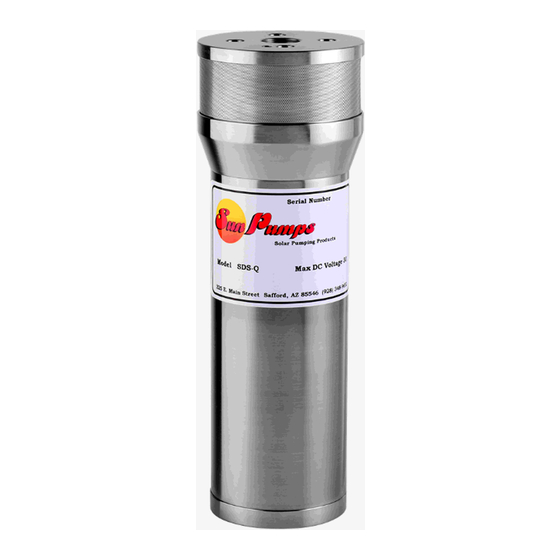Advertisement
Table of Contents
SDS-Q SERIES PUMP REBUILD INSTRUCTIONS
Bottom Mounted Pistons
DISASSEMBLY
1. Remove cable guard screws and cable guard.
2. Loosen the 4 discharge head screws about 4 turns each but do not remove at
this time. With a rubber mallet tap the discharge head to break the bond between
the head and the diaphragm. This will relieve any pressure in the motor housing.
WARNING: PUMP HOUSING MAY BE UNDER HIGH PRESSURE. USE
EXTREME CAUTION IN REMOVING THE DISCHARGE HEAD.
3. Turn the pump over and remove the 3/8" set screw using 3/16" hex wrench
and the two socket head screws from end cap using a 5/32" hex wrench.
4. Clamp the pump in the puller and screw the proper threaded mandrel in the
end cap.
5. Pull the end cap out of the stainless housing. If the brass ends seem to be
stuck, warm the stainless housing slightly with a small propane torch, being
careful not to overheat and warp the housing. As the end cap comes out
disconnect the two motor wires plugged into the cap.
6. With the end cap removed from the housing turn the pump around, screw the
appropriate mandrel into the discharge head, and remove the pump assembly
from the stainless housing.
7. Remove the four socket head screws from the discharge head using a 5/32"
hex wrench.
8. Remove the suction screen, check valve assembly, relief valve assembly and
o-rings from the discharge head. Note: Check valve removal may require a
light tap with a blunt tool through the discharge opening.
9. Remove the four motor adapter screws using a 5/32" hex wrench. Remove the
set screw from the cam assembly using a long 1/8" hex wrench. This wrench
must be inserted through the hole in the side of the motor adapter. Before
inserting the wrench, visually align the set screw with the hole by turning the
motor adapter while holding the motor.
10. Pull the motor adapter and cam assembly away from the motor, remove the
four piston screws and then the cam assembly.
11. Clean and inspect all parts to be reused and make sure the electrical studs
protruding from the epoxy in the end cap are in good condition and the epoxy is
still hard.
Advertisement
Table of Contents

Summary of Contents for SUNPUMPS SDS-Q Series
- Page 1 SDS-Q SERIES PUMP REBUILD INSTRUCTIONS Bottom Mounted Pistons DISASSEMBLY 1. Remove cable guard screws and cable guard. 2. Loosen the 4 discharge head screws about 4 turns each but do not remove at this time. With a rubber mallet tap the discharge head to break the bond between the head and the diaphragm.
- Page 2 SDS-Q SERIES PUMP REBUILD INSTRUCTIONS ASSEMBLY 1. Set the brass pistons flat side down on the pump assembly plate, positioning the two holes over locating studs. 2. Place the diaphragm face down over the pistons locating the piston shafts through the four holes. CAUTION: NEVER USE ANY TYPE OF GREASE ON THE DIAPHRAGM, IT MAY CAUSE DIAPHRAGM FAILURE.
- Page 3 14. Install the o-ring into the check valve and insert the check valve into the discharge head making sure check valve assembly is flush with discharge head. Turn the discharge head over and insert the four washers and the stainless head bolts in the 4 countersunk holes.



Need help?
Do you have a question about the SDS-Q Series and is the answer not in the manual?
Questions and answers